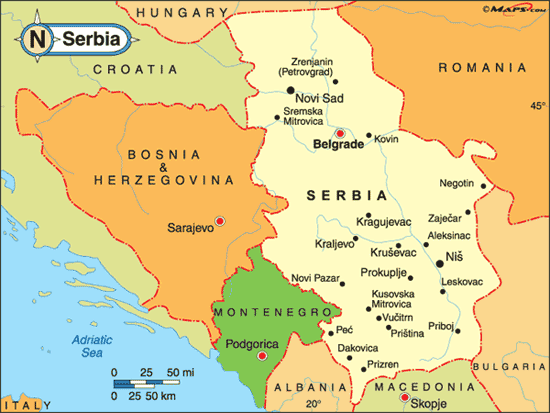
Timeline
3rd century- Celtic settlement
11th to 15th century- Serbian kingdom under its own rule
1453 to 1804- Ottoman Empire ruled over Serbia
19th century- Serbia finally grew apart from the Ottoman Empire
1918- Serbia joined with other lands from the Habsburg monarchy, creating the Kingdom of the Serbs, Croats, and Slovenes.
1929- Kingdom of the Serbs is recognized as the Kingdom of Yugoslavia or "South Slavia" in English
1941- Serbia became puppet state of Nazi Germany
1945- Serbia rejoined communist Yugoslavia
1991- Yugoslavia dissolved, Serbia and Montenegro became part of the Federal Republic of Yugoslavia
1998- War in Kosovo
2003- Serbia and Montenegro created a new constitution
War
During the late 90's and early 2000's there was a lot of upheaval in Serbia with an intense war against ethnic Albanians living in Kosovo. In the Serbian province of Kosovo, Serbian campaigns massacred ethnic Albanians, which eventually led to the NATO bombing in Serbia in 1999. Many ethnic Albanian refugees fled to Montenegro for safety. Through the following years, with Yugoslavia dissolved, Serbia and Montenegro tried to establish two independent republics. Intense violence towards ethnic Serbians in Kosovo continued, which caused the UN to start addressing Kosovo's status. Montenegro became an independent nation in 2006.
In 2008, Kosovo attempted to declare itself an independent nation, but Serbia wouldn't recognize this. There has been an ongoing discussion about the results, and finally in 2013, Serbia and Kosovo signed the first agreement that normalized relations between both countries.


Religion
Overall the dominating religion in Serbia is Orthodox Christian. This was established in the 13th century by Saint Sava. With such a long occupation by the Ottoman Empire, religion became a big part of the Serbian identity due to many Turkish policies during the occupation. Now, in modern times, Serbians aren’t overly religious. There are practicing Slavic Muslim, Protestant, and Catholic groups, but they're fewer compared to the Orthodox Christian population.
Language

Serbian is part of the South Slavic languages, which encompasses Slovenian, Bulgarian, Macedonian, Croatian, and Bosnian. These languages are complicated, as so is the history of these countries. As a result of all the changes in Serbia, the language spoken and ongoing politics are interconnected.
There are striking similarities between Croatian and Serbian. So similar, in fact, The Novi Sad Agreement was made in 1954 that united both languages referred to as Serbo-Croatian. This language had a different grammatical structure and dialect. This agreement didn’t stick because Croatian protesters were angry about the Serbian dialect being spoken on their land.
After the collapse of Yugoslavia, both Croatians and Serbians use different dialects of essentially the same language. Croatians use the ijekavian form of štokavian and Serbians use the ekavian form.
Present day, both variants are spoken in Serbia.
Serbian is in Cyrillic and Latin script
Location
Landlocked. Borders: Bulgaria, Romania, Hungary, Croatia, Bosnia, Albania and Macedonia.
Serbia is often referred to as the crossroads of Europe, located on the central part of the Balkan peninsula. Rivers and railways create the shortest path between Western and Central Europe, and the Middle East, Asia and Africa. The roads are close to the river Morava which split approaching the city Nis. The rivers have separate names where they split, one named Jusna Moraca and Vardar heads towards Thessaloniki, and Nisava River goes towards Sofia and Istanbul.





Coat of Arms
National Symbol
Legal Status of Minorites
Minorities have constitutional rights and are guaranteed equality along with freedom of religion. They are even allowed to elect representatives through the national council to self govern in areas such as culture, education, language etc. They have many rights, and there are national rules to protect minorities. For example, discrimination is prohibited and tolerance is encouraged to promote respect among citizens.
21 minorities in Serbia have their own national council. This includes: Bunjevci, Bulgarians, Bosnians, Hungarians, Roma, Romanians, Russians, Slovaks, Ukrainians, Croats, Albanians, Ashkali, Vlachs, Greeks, Egyptians, Germans, Slovenes, Czechs, Macedonians, Montenegrins and the Federation of Jewish Communities
Population
7,176,794